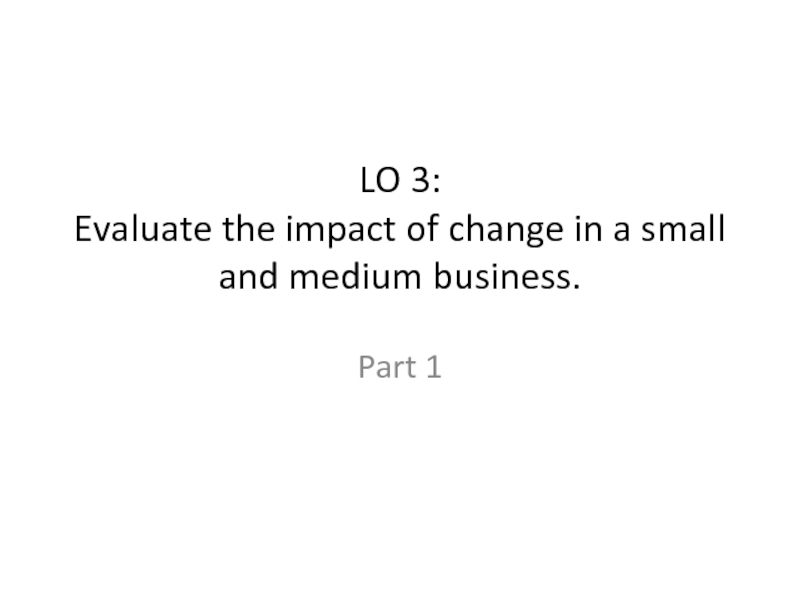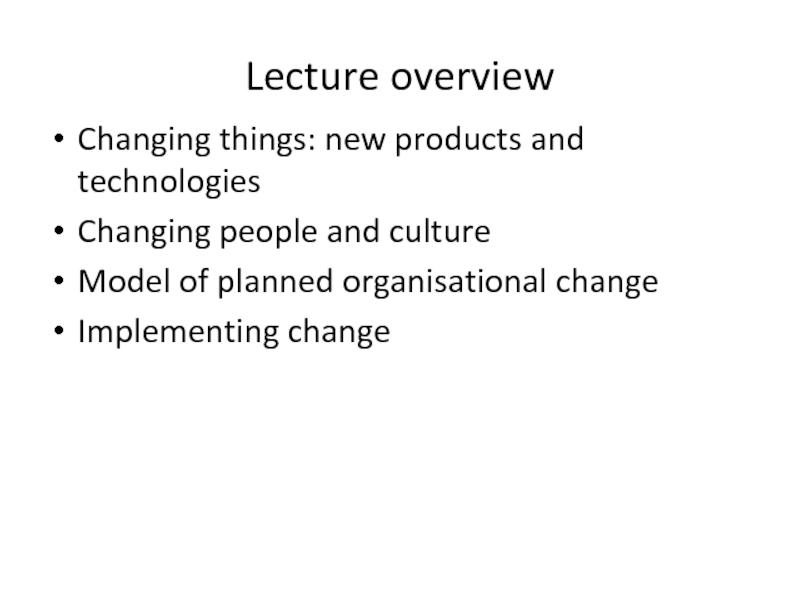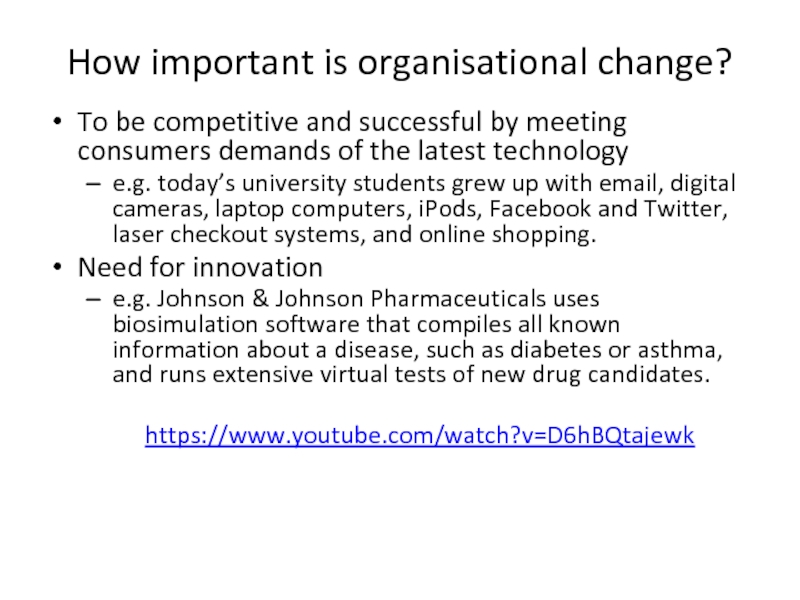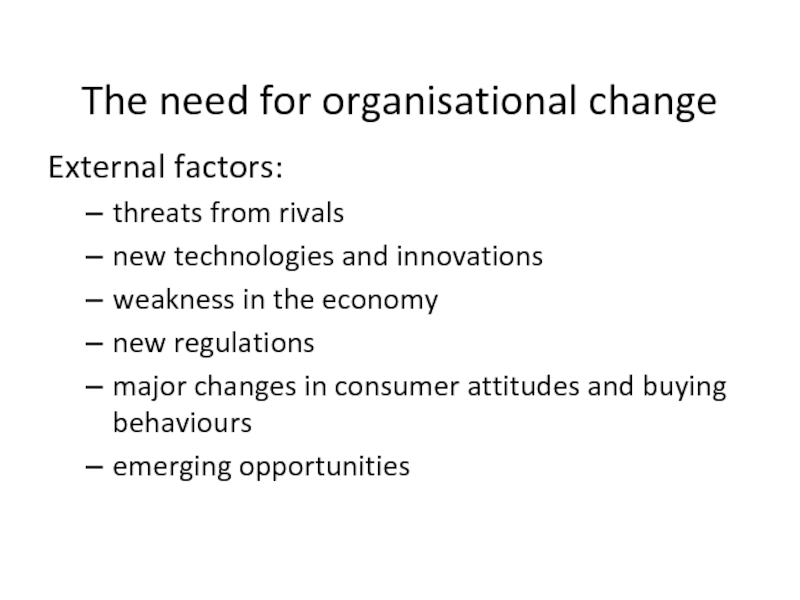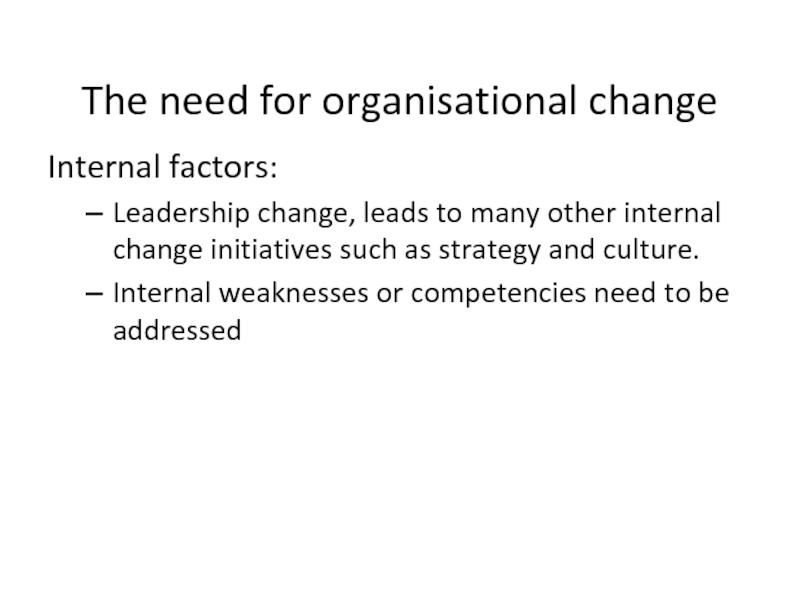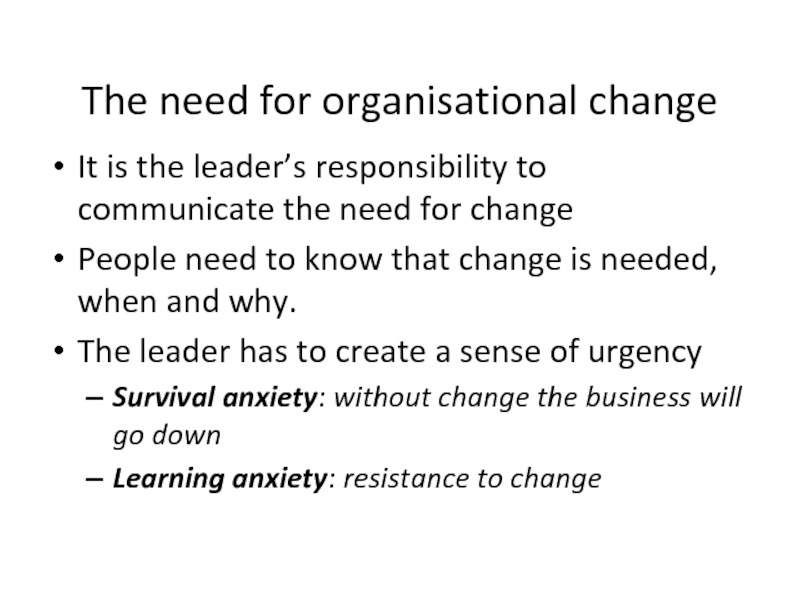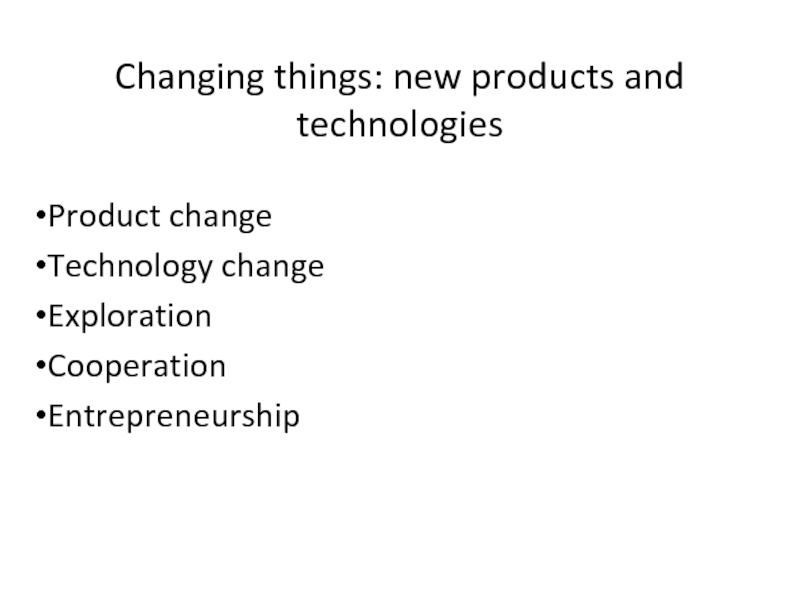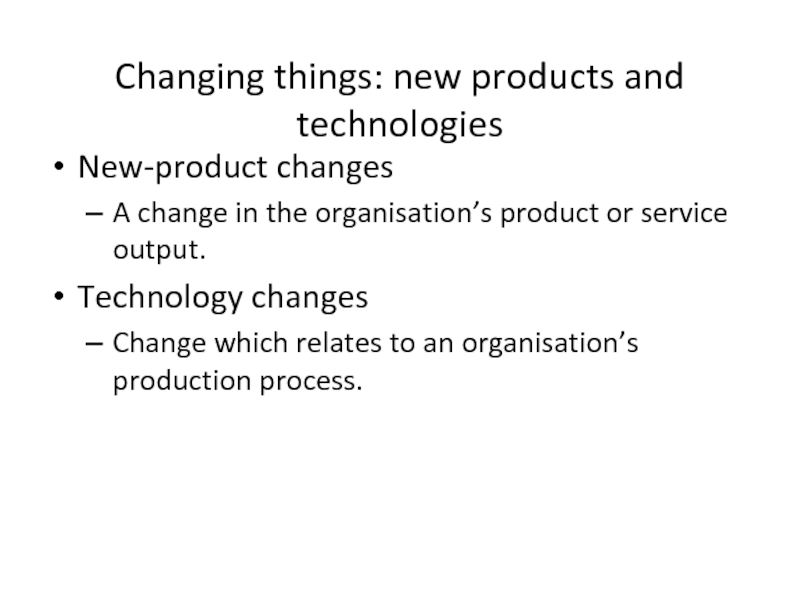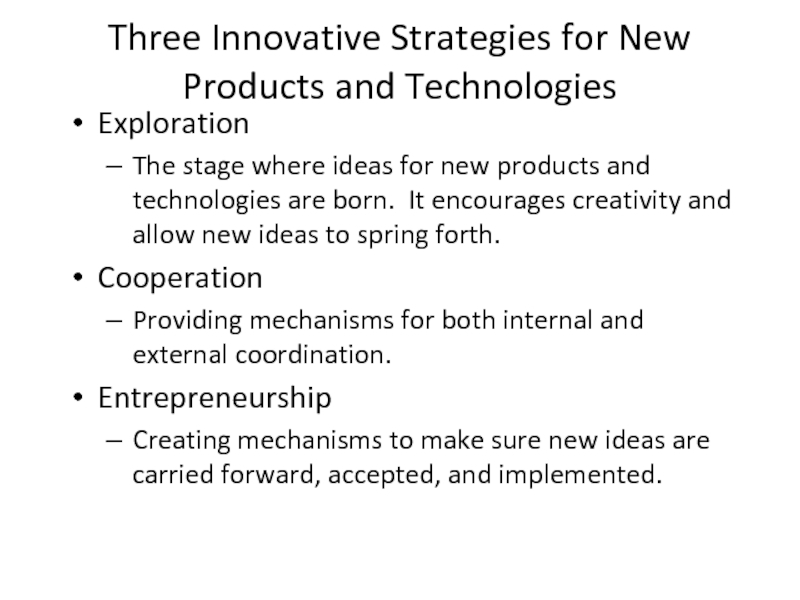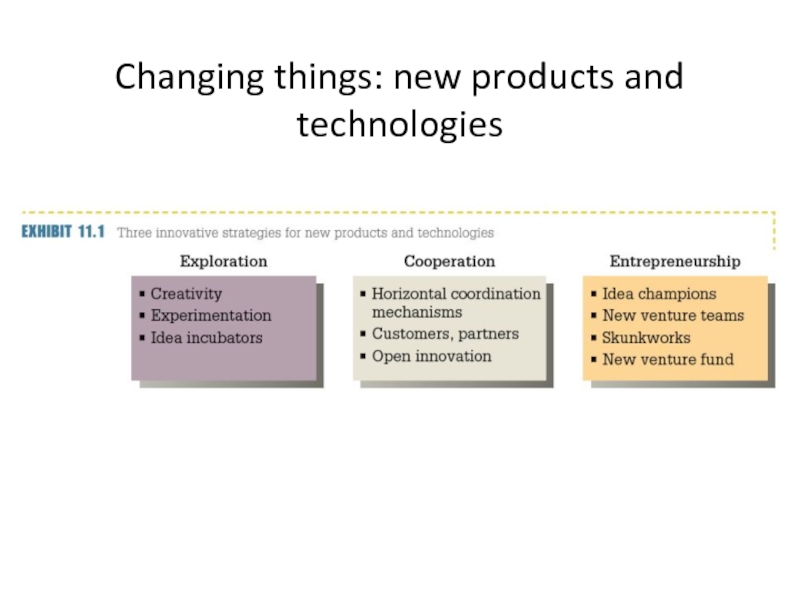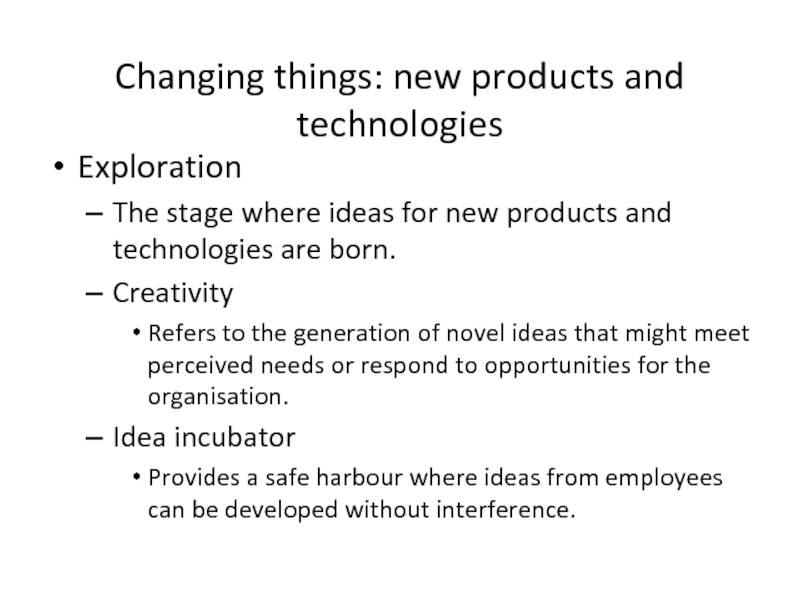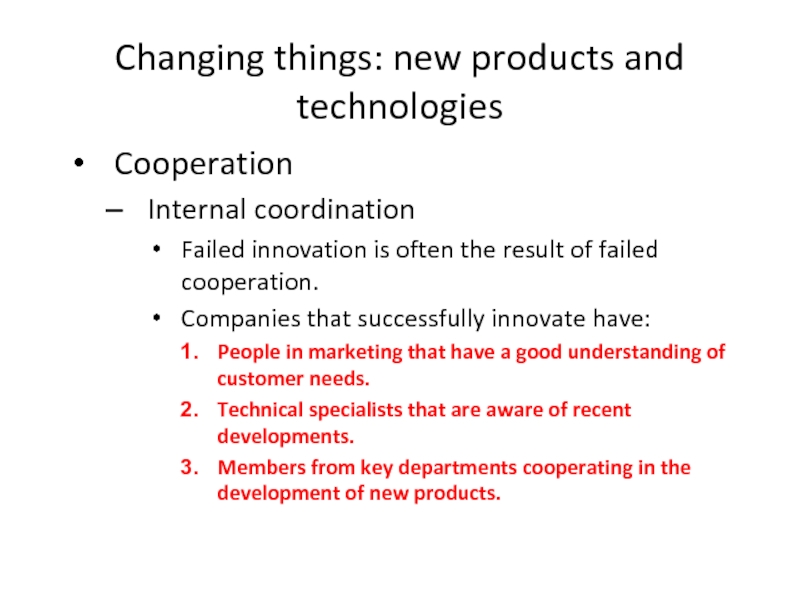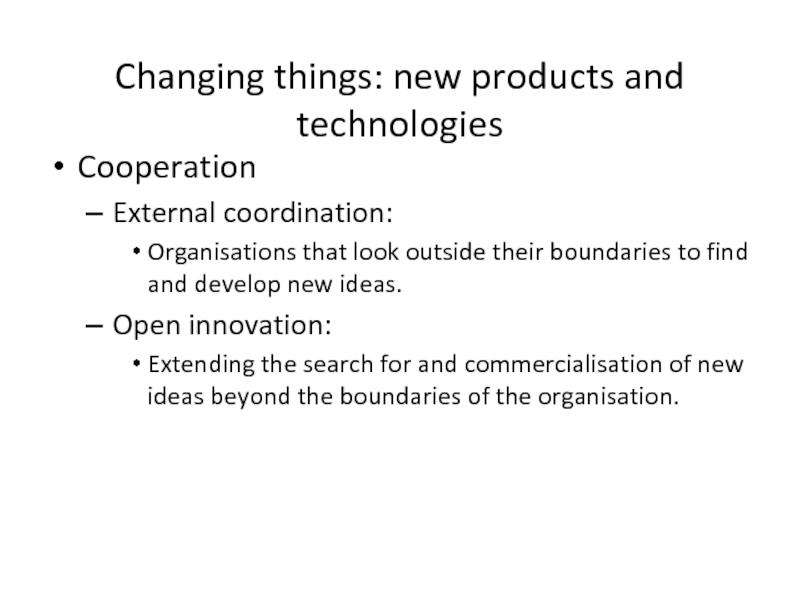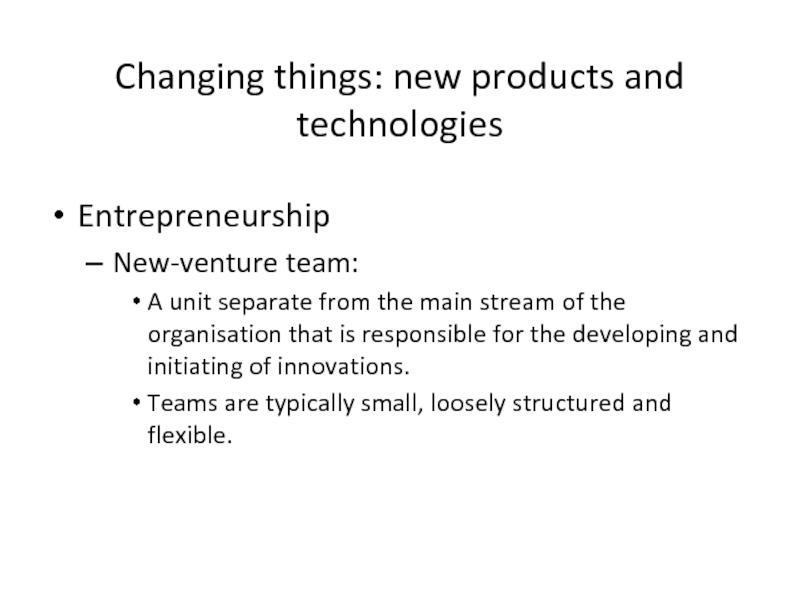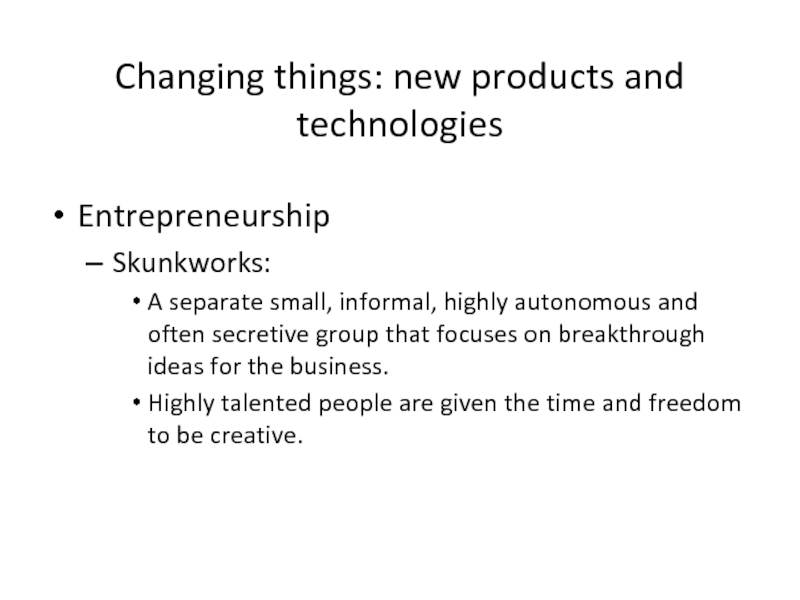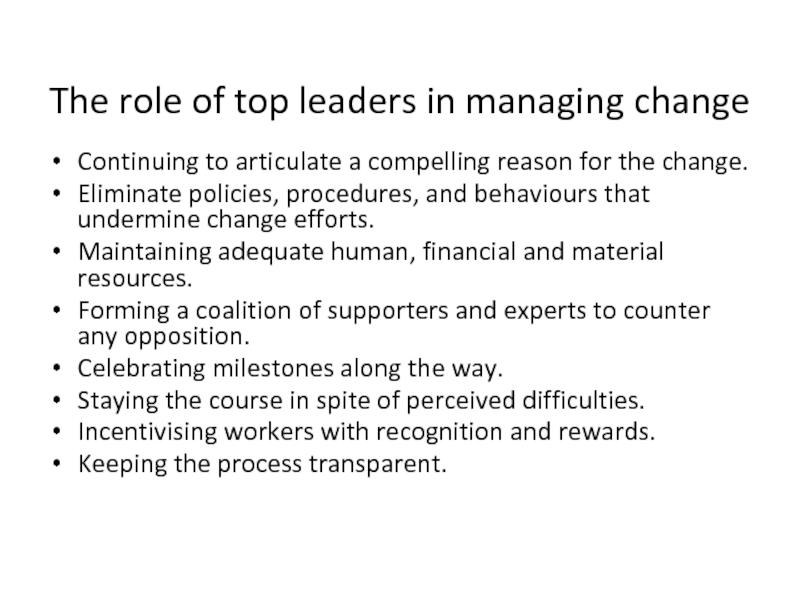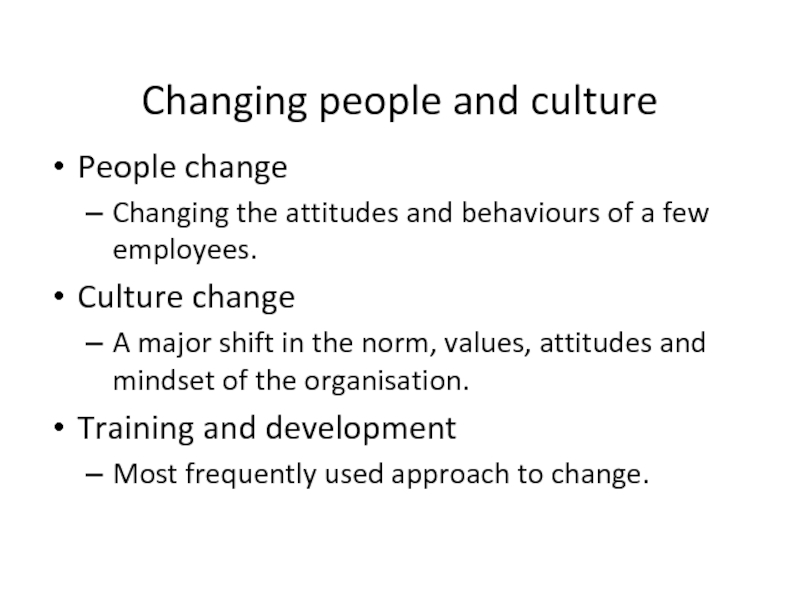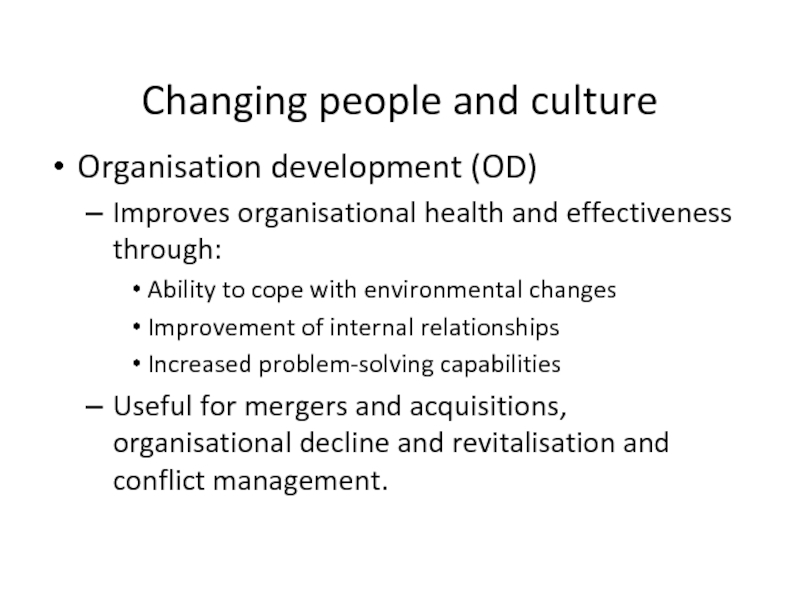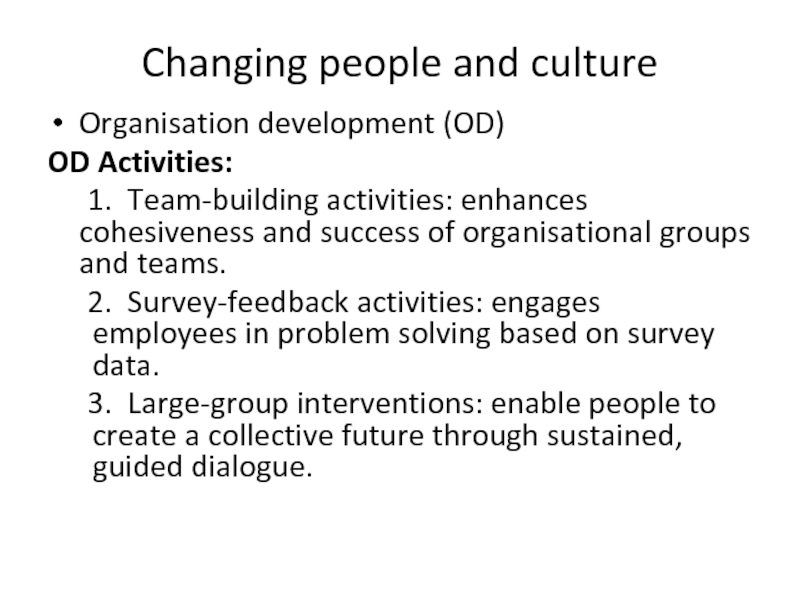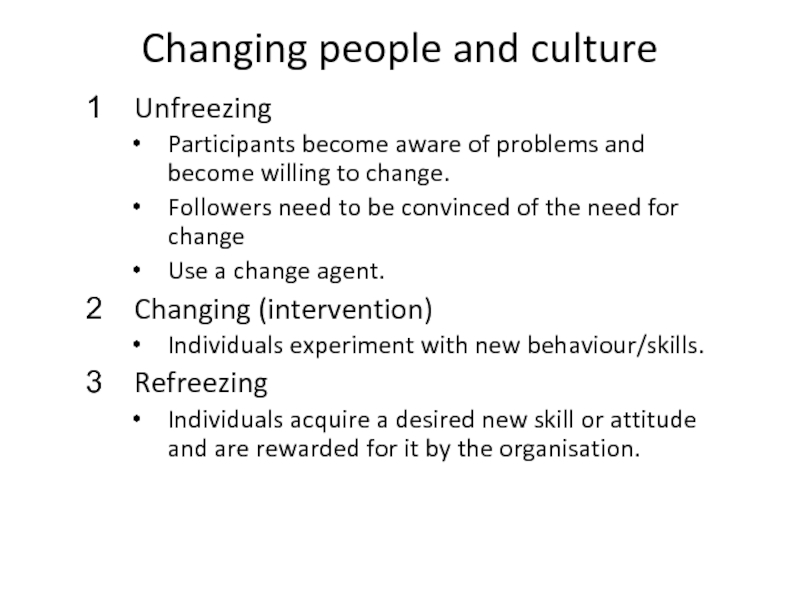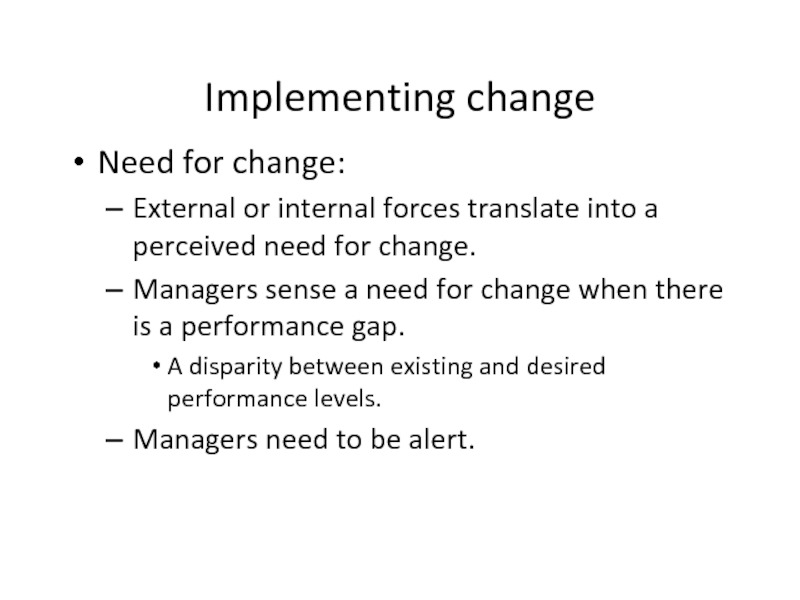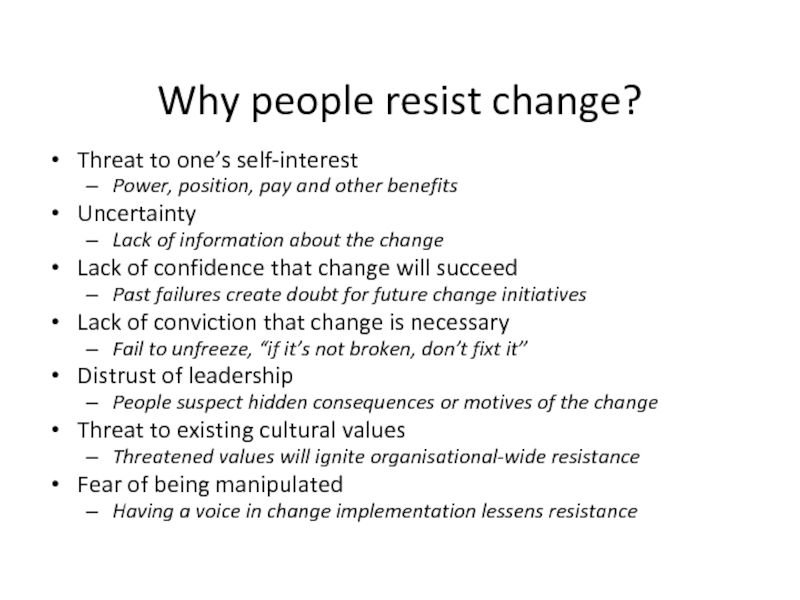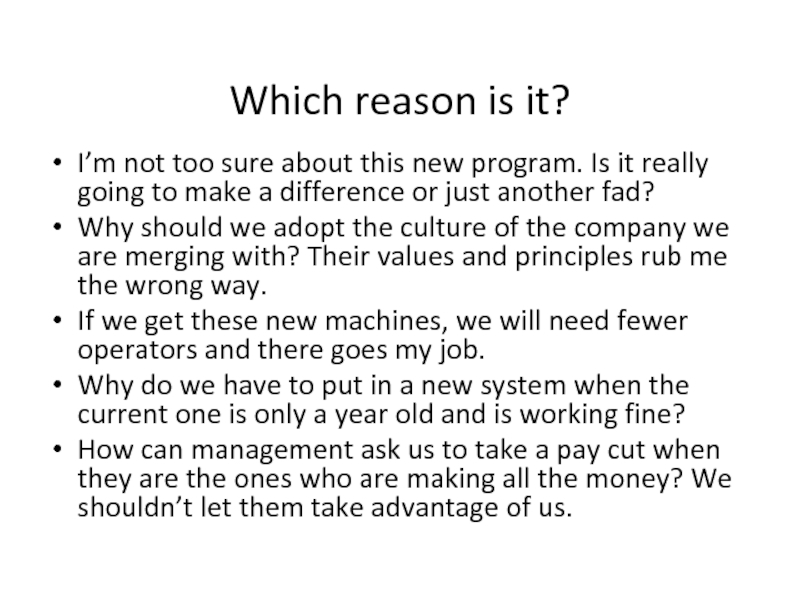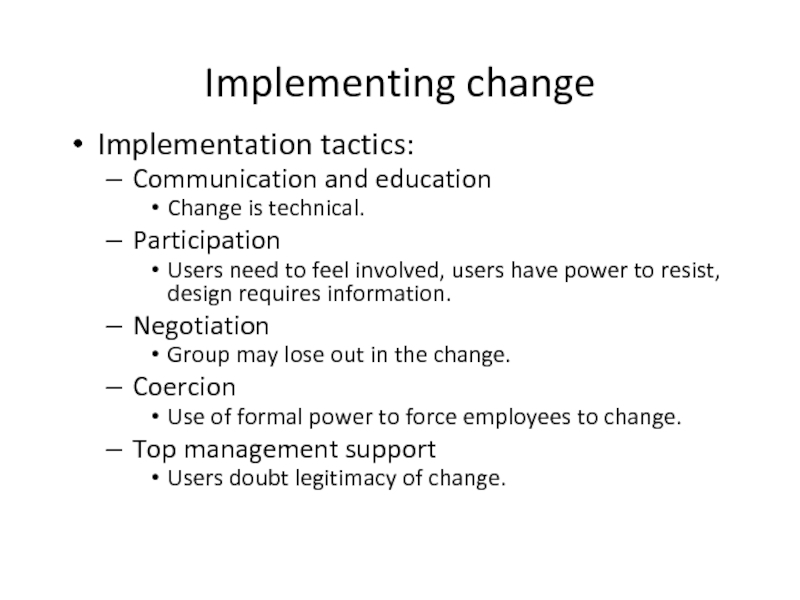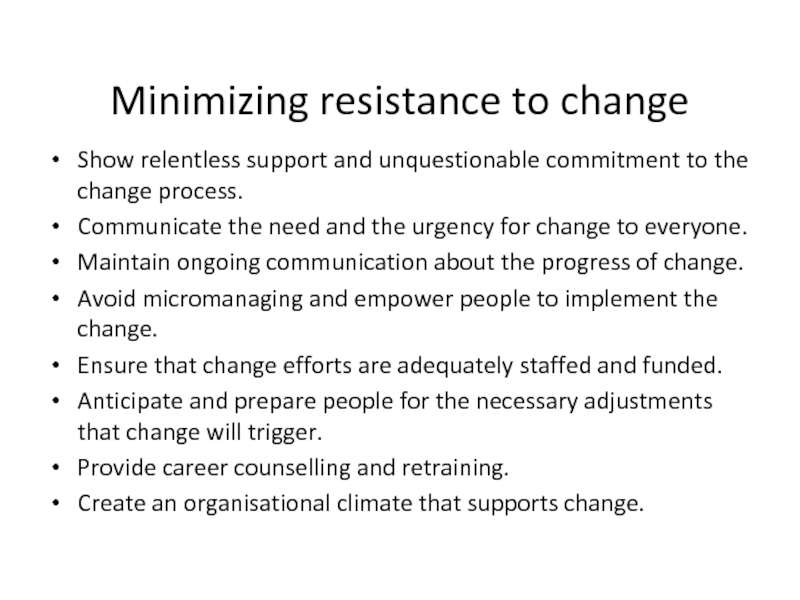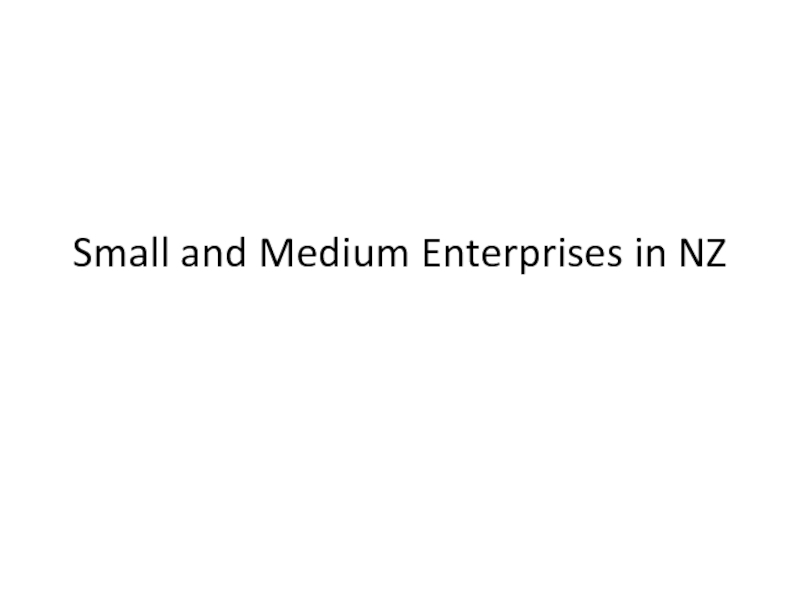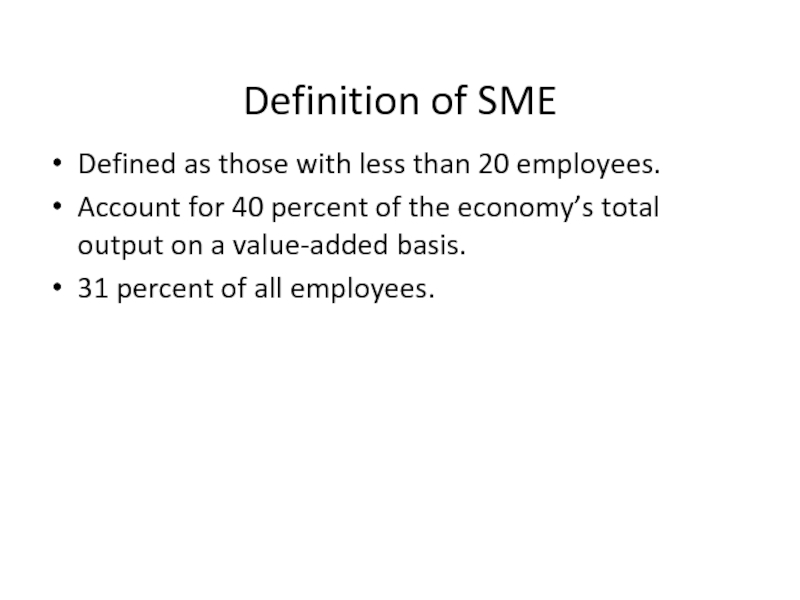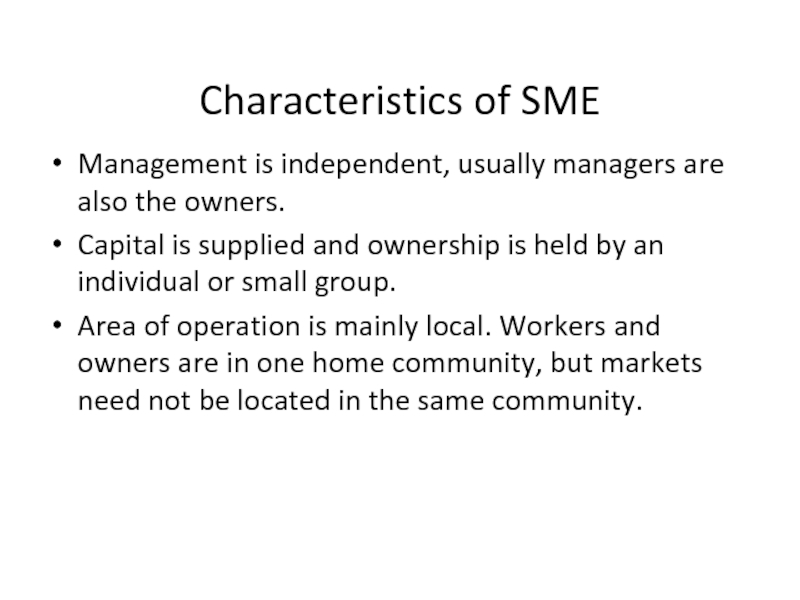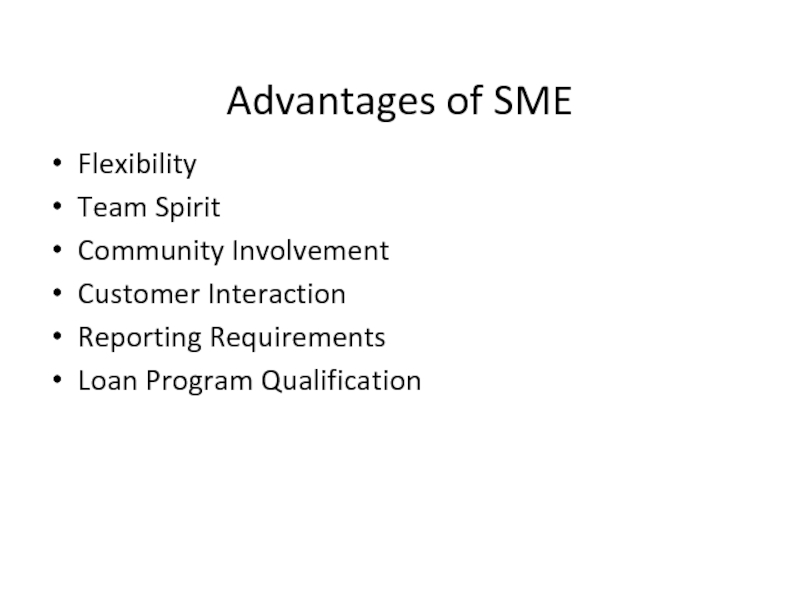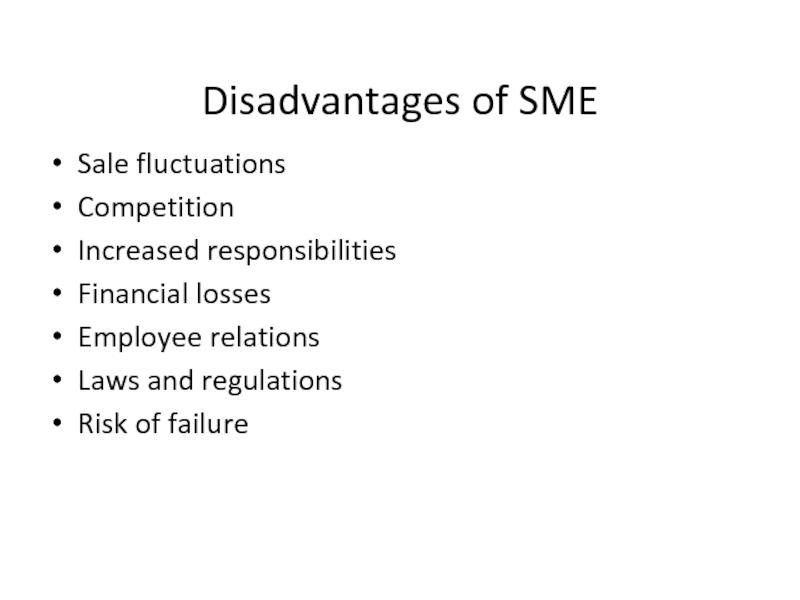Part 1
- Главная
- Разное
- Дизайн
- Бизнес и предпринимательство
- Аналитика
- Образование
- Развлечения
- Красота и здоровье
- Финансы
- Государство
- Путешествия
- Спорт
- Недвижимость
- Армия
- Графика
- Культурология
- Еда и кулинария
- Лингвистика
- Английский язык
- Астрономия
- Алгебра
- Биология
- География
- Детские презентации
- Информатика
- История
- Литература
- Маркетинг
- Математика
- Медицина
- Менеджмент
- Музыка
- МХК
- Немецкий язык
- ОБЖ
- Обществознание
- Окружающий мир
- Педагогика
- Русский язык
- Технология
- Физика
- Философия
- Химия
- Шаблоны, картинки для презентаций
- Экология
- Экономика
- Юриспруденция
Managing. Organisational change презентация
Содержание
- 1. Managing. Organisational change
- 2. Lecture overview Changing things: new products and
- 3. How important is organisational change? To be
- 4. The need for organisational change External factors:
- 5. The need for organisational change Internal factors:
- 6. The need for organisational change It is
- 7. Changing things: new products and technologies Product change Technology change Exploration Cooperation Entrepreneurship
- 8. Changing things: new products and technologies New-product
- 9. Three Innovative Strategies for New Products and
- 10. Changing things: new products and technologies
- 11. Changing things: new products and technologies Exploration
- 12. Changing things: new products and technologies Cooperation
- 13. Changing things: new products and technologies Cooperation
- 14. Changing things: new products and technologies
- 15. Changing things: new products and technologies
- 16. The role of top leaders in managing
- 17. Changing people and culture People change Changing
- 18. Changing people and culture Organisation development (OD)
- 19. Changing people and culture Organisation development (OD)
- 20. Changing people and culture Unfreezing Participants become
- 21. Implementing change Need for change: External or
- 22. Why people resist change? Threat to one’s
- 23. Which reason is it? I’m not too
- 24. Implementing change Implementation tactics: Communication and education
- 25. Minimizing resistance to change Show relentless support
- 26. Small and Medium Enterprises in NZ
- 27. Definition of SME Defined as those with
- 28. Characteristics of SME Management is independent, usually
- 29. Advantages of SME Flexibility Team Spirit Community
- 30. Disadvantages of SME Sale fluctuations Competition Increased
Слайд 2Lecture overview
Changing things: new products and technologies
Changing people and culture
Model of
planned organisational change
Implementing change
Implementing change
Слайд 3How important is organisational change?
To be competitive and successful by meeting
consumers demands of the latest technology
e.g. today’s university students grew up with email, digital cameras, laptop computers, iPods, Facebook and Twitter, laser checkout systems, and online shopping.
Need for innovation
e.g. Johnson & Johnson Pharmaceuticals uses biosimulation software that compiles all known information about a disease, such as diabetes or asthma, and runs extensive virtual tests of new drug candidates.
https://www.youtube.com/watch?v=D6hBQtajewk
e.g. today’s university students grew up with email, digital cameras, laptop computers, iPods, Facebook and Twitter, laser checkout systems, and online shopping.
Need for innovation
e.g. Johnson & Johnson Pharmaceuticals uses biosimulation software that compiles all known information about a disease, such as diabetes or asthma, and runs extensive virtual tests of new drug candidates.
https://www.youtube.com/watch?v=D6hBQtajewk
Слайд 4The need for organisational change
External factors:
threats from rivals
new technologies and innovations
weakness
in the economy
new regulations
major changes in consumer attitudes and buying behaviours
emerging opportunities
new regulations
major changes in consumer attitudes and buying behaviours
emerging opportunities
Слайд 5The need for organisational change
Internal factors:
Leadership change, leads to many other
internal change initiatives such as strategy and culture.
Internal weaknesses or competencies need to be addressed
Internal weaknesses or competencies need to be addressed
Слайд 6The need for organisational change
It is the leader’s responsibility to communicate
the need for change
People need to know that change is needed, when and why.
The leader has to create a sense of urgency
Survival anxiety: without change the business will go down
Learning anxiety: resistance to change
People need to know that change is needed, when and why.
The leader has to create a sense of urgency
Survival anxiety: without change the business will go down
Learning anxiety: resistance to change
Слайд 7Changing things: new products and technologies
Product change
Technology change
Exploration
Cooperation
Entrepreneurship
Слайд 8Changing things: new products and technologies
New-product changes
A change in the organisation’s
product or service output.
Technology changes
Change which relates to an organisation’s production process.
Technology changes
Change which relates to an organisation’s production process.
Слайд 9Three Innovative Strategies for New Products and Technologies
Exploration
The stage where ideas
for new products and technologies are born. It encourages creativity and allow new ideas to spring forth.
Cooperation
Providing mechanisms for both internal and external coordination.
Entrepreneurship
Creating mechanisms to make sure new ideas are carried forward, accepted, and implemented.
Cooperation
Providing mechanisms for both internal and external coordination.
Entrepreneurship
Creating mechanisms to make sure new ideas are carried forward, accepted, and implemented.
Слайд 11Changing things: new products and technologies
Exploration
The stage where ideas for new
products and technologies are born.
Creativity
Refers to the generation of novel ideas that might meet perceived needs or respond to opportunities for the organisation.
Idea incubator
Provides a safe harbour where ideas from employees can be developed without interference.
Creativity
Refers to the generation of novel ideas that might meet perceived needs or respond to opportunities for the organisation.
Idea incubator
Provides a safe harbour where ideas from employees can be developed without interference.
Слайд 12Changing things: new products and technologies
Cooperation
Internal coordination
Failed innovation is often the
result of failed cooperation.
Companies that successfully innovate have:
People in marketing that have a good understanding of customer needs.
Technical specialists that are aware of recent developments.
Members from key departments cooperating in the development of new products.
Companies that successfully innovate have:
People in marketing that have a good understanding of customer needs.
Technical specialists that are aware of recent developments.
Members from key departments cooperating in the development of new products.
Слайд 13Changing things: new products and technologies
Cooperation
External coordination:
Organisations that look outside their
boundaries to find and develop new ideas.
Open innovation:
Extending the search for and commercialisation of new ideas beyond the boundaries of the organisation.
Open innovation:
Extending the search for and commercialisation of new ideas beyond the boundaries of the organisation.
Слайд 14Changing things: new products and technologies
Entrepreneurship
New-venture team:
A unit separate from the
main stream of the organisation that is responsible for the developing and initiating of innovations.
Teams are typically small, loosely structured and flexible.
Teams are typically small, loosely structured and flexible.
Слайд 15Changing things: new products and technologies
Entrepreneurship
Skunkworks:
A separate small, informal, highly autonomous
and often secretive group that focuses on breakthrough ideas for the business.
Highly talented people are given the time and freedom to be creative.
Highly talented people are given the time and freedom to be creative.
Слайд 16The role of top leaders in managing change
Continuing to articulate a
compelling reason for the change.
Eliminate policies, procedures, and behaviours that undermine change efforts.
Maintaining adequate human, financial and material resources.
Forming a coalition of supporters and experts to counter any opposition.
Celebrating milestones along the way.
Staying the course in spite of perceived difficulties.
Incentivising workers with recognition and rewards.
Keeping the process transparent.
Eliminate policies, procedures, and behaviours that undermine change efforts.
Maintaining adequate human, financial and material resources.
Forming a coalition of supporters and experts to counter any opposition.
Celebrating milestones along the way.
Staying the course in spite of perceived difficulties.
Incentivising workers with recognition and rewards.
Keeping the process transparent.
Слайд 17Changing people and culture
People change
Changing the attitudes and behaviours of a
few employees.
Culture change
A major shift in the norm, values, attitudes and mindset of the organisation.
Training and development
Most frequently used approach to change.
Culture change
A major shift in the norm, values, attitudes and mindset of the organisation.
Training and development
Most frequently used approach to change.
Слайд 18Changing people and culture
Organisation development (OD)
Improves organisational health and effectiveness through:
Ability
to cope with environmental changes
Improvement of internal relationships
Increased problem-solving capabilities
Useful for mergers and acquisitions, organisational decline and revitalisation and conflict management.
Improvement of internal relationships
Increased problem-solving capabilities
Useful for mergers and acquisitions, organisational decline and revitalisation and conflict management.
Слайд 19Changing people and culture
Organisation development (OD)
OD Activities:
1. Team-building activities: enhances cohesiveness and
success of organisational groups and teams.
2. Survey-feedback activities: engages employees in problem solving based on survey data.
3. Large-group interventions: enable people to create a collective future through sustained, guided dialogue.
2. Survey-feedback activities: engages employees in problem solving based on survey data.
3. Large-group interventions: enable people to create a collective future through sustained, guided dialogue.
Слайд 20Changing people and culture
Unfreezing
Participants become aware of problems and become willing
to change.
Followers need to be convinced of the need for change
Use a change agent.
Changing (intervention)
Individuals experiment with new behaviour/skills.
Refreezing
Individuals acquire a desired new skill or attitude and are rewarded for it by the organisation.
Followers need to be convinced of the need for change
Use a change agent.
Changing (intervention)
Individuals experiment with new behaviour/skills.
Refreezing
Individuals acquire a desired new skill or attitude and are rewarded for it by the organisation.
Слайд 21Implementing change
Need for change:
External or internal forces translate into a perceived
need for change.
Managers sense a need for change when there is a performance gap.
A disparity between existing and desired performance levels.
Managers need to be alert.
Managers sense a need for change when there is a performance gap.
A disparity between existing and desired performance levels.
Managers need to be alert.
Слайд 22Why people resist change?
Threat to one’s self-interest
Power, position, pay and other
benefits
Uncertainty
Lack of information about the change
Lack of confidence that change will succeed
Past failures create doubt for future change initiatives
Lack of conviction that change is necessary
Fail to unfreeze, “if it’s not broken, don’t fixt it”
Distrust of leadership
People suspect hidden consequences or motives of the change
Threat to existing cultural values
Threatened values will ignite organisational-wide resistance
Fear of being manipulated
Having a voice in change implementation lessens resistance
Uncertainty
Lack of information about the change
Lack of confidence that change will succeed
Past failures create doubt for future change initiatives
Lack of conviction that change is necessary
Fail to unfreeze, “if it’s not broken, don’t fixt it”
Distrust of leadership
People suspect hidden consequences or motives of the change
Threat to existing cultural values
Threatened values will ignite organisational-wide resistance
Fear of being manipulated
Having a voice in change implementation lessens resistance
Слайд 23Which reason is it?
I’m not too sure about this new program.
Is it really going to make a difference or just another fad?
Why should we adopt the culture of the company we are merging with? Their values and principles rub me the wrong way.
If we get these new machines, we will need fewer operators and there goes my job.
Why do we have to put in a new system when the current one is only a year old and is working fine?
How can management ask us to take a pay cut when they are the ones who are making all the money? We shouldn’t let them take advantage of us.
Why should we adopt the culture of the company we are merging with? Their values and principles rub me the wrong way.
If we get these new machines, we will need fewer operators and there goes my job.
Why do we have to put in a new system when the current one is only a year old and is working fine?
How can management ask us to take a pay cut when they are the ones who are making all the money? We shouldn’t let them take advantage of us.
Слайд 24Implementing change
Implementation tactics:
Communication and education
Change is technical.
Participation
Users need to feel involved,
users have power to resist, design requires information.
Negotiation
Group may lose out in the change.
Coercion
Use of formal power to force employees to change.
Top management support
Users doubt legitimacy of change.
Negotiation
Group may lose out in the change.
Coercion
Use of formal power to force employees to change.
Top management support
Users doubt legitimacy of change.
Слайд 25Minimizing resistance to change
Show relentless support and unquestionable commitment to the
change process.
Communicate the need and the urgency for change to everyone.
Maintain ongoing communication about the progress of change.
Avoid micromanaging and empower people to implement the change.
Ensure that change efforts are adequately staffed and funded.
Anticipate and prepare people for the necessary adjustments that change will trigger.
Provide career counselling and retraining.
Create an organisational climate that supports change.
Communicate the need and the urgency for change to everyone.
Maintain ongoing communication about the progress of change.
Avoid micromanaging and empower people to implement the change.
Ensure that change efforts are adequately staffed and funded.
Anticipate and prepare people for the necessary adjustments that change will trigger.
Provide career counselling and retraining.
Create an organisational climate that supports change.
Слайд 27Definition of SME
Defined as those with less than 20 employees.
Account
for 40 percent of the economy’s total output on a value-added basis.
31 percent of all employees.
31 percent of all employees.
Слайд 28Characteristics of SME
Management is independent, usually managers are also the owners.
Capital
is supplied and ownership is held by an individual or small group.
Area of operation is mainly local. Workers and owners are in one home community, but markets need not be located in the same community.
Area of operation is mainly local. Workers and owners are in one home community, but markets need not be located in the same community.
